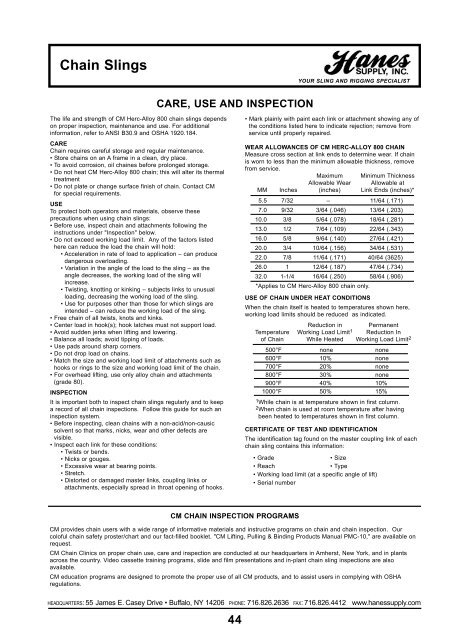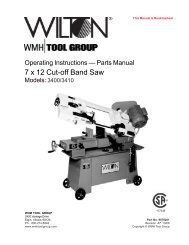This Rigger's Handbook is dedicated to Theodore C - Igor Chudov
This Rigger's Handbook is dedicated to Theodore C - Igor Chudov
This Rigger's Handbook is dedicated to Theodore C - Igor Chudov
Create successful ePaper yourself
Turn your PDF publications into a flip-book with our unique Google optimized e-Paper software.
Chain Slings<br />
The life and strength of CM Herc-Alloy 800 chain slings depends<br />
on proper inspection, maintenance and use. For additional<br />
information, refer <strong>to</strong> ANSI B30.9 and OSHA 1920.184.<br />
CARE<br />
Chain requires careful s<strong>to</strong>rage and regular maintenance.<br />
• S<strong>to</strong>re chains on an A frame in a clean, dry place.<br />
• To avoid corrosion, oil chaines before prolonged s<strong>to</strong>rage.<br />
• Do not heat CM Herc-Alloy 800 chain; th<strong>is</strong> will alter its thermal<br />
treatment<br />
• Do not plate or change surface fin<strong>is</strong>h of chain. Contact CM<br />
for special requirements.<br />
USE<br />
To protect both opera<strong>to</strong>rs and materials, observe these<br />
precautions when using chain slings:<br />
• Before use, inspect chain and attachments following the<br />
instructions under "Inspection" below.<br />
• Do not exceed working load limit. Any of the fac<strong>to</strong>rs l<strong>is</strong>ted<br />
here can reduce the load the chain will hold:<br />
• Acceleration in rate of load <strong>to</strong> application – can produce<br />
dangerous overloading.<br />
• Variation in the angle of the load <strong>to</strong> the sling – as the<br />
angle decreases, the working load of the sling will<br />
increase.<br />
• Tw<strong>is</strong>ting, knotting or kinking – subjects links <strong>to</strong> unusual<br />
loading, decreasing the working load of the sling.<br />
• Use for purposes other than those for which slings are<br />
intended – can reduce the working load of the sling.<br />
• Free chain of all tw<strong>is</strong>ts, knots and kinks.<br />
• Center load in hook(s); hook latches must not support load.<br />
• Avoid sudden jerks when lifting and lowering.<br />
• Balance all loads; avoid tipping of loads.<br />
• Use pads around sharp corners.<br />
• Do not drop load on chains.<br />
• Match the size and working load limit of attachments such as<br />
hooks or rings <strong>to</strong> the size and working load limit of the chain.<br />
• For overhead lifting, use only alloy chain and attachments<br />
(grade 80).<br />
INSPECTION<br />
It <strong>is</strong> important both <strong>to</strong> inspect chain slings regularly and <strong>to</strong> keep<br />
a record of all chain inspections. Follow th<strong>is</strong> guide for such an<br />
inspection system.<br />
• Before inspecting, clean chains with a non-acid/non-causic<br />
solvent so that marks, nicks, wear and other defects are<br />
v<strong>is</strong>ible.<br />
• Inspect each link for these conditions:<br />
• Tw<strong>is</strong>ts or bends.<br />
• Nicks or gouges.<br />
• Excessive wear at bearing points.<br />
• Stretch.<br />
• D<strong>is</strong><strong>to</strong>rted or damaged master links, coupling links or<br />
attachments, especially spread in throat opening of hooks.<br />
CARE, USE AND INSPECTION<br />
CM CHAIN INSPECTION PROGRAMS<br />
HEADQUARTERS: 55 James E. Casey Drive • Buffalo, NY 14206 PHONE: 716.826.2636 FAX: 716.826.4412 www.hanessupply.com<br />
44<br />
YOUR SLING AND RIGGING SPECIALIST<br />
• Mark plainly with paint each link or attachment showing any of<br />
the conditions l<strong>is</strong>ted here <strong>to</strong> indicate rejection; remove from<br />
service until properly repaired.<br />
WEAR ALLOWANCES OF CM HERC-ALLOY 800 CHAIN<br />
Measure cross section at link ends <strong>to</strong> determine wear. If chain<br />
<strong>is</strong> worn <strong>to</strong> less than the minimum allowable thickness, remove<br />
from service.<br />
Maximum Minimum Thickness<br />
Allowable Wear Allowable at<br />
MM Inches (inches) Link Ends (inches)*<br />
5.5 7/32 – – – – 11/64 (.171)<br />
7.0 9/32 3/64 (.046) 13/64 (.203)<br />
10.0 3/8 5/64 (.078) 18/64 (.281)<br />
13.0 1/2 7/64 (.109) 22/64 (.343)<br />
16.0 5/8 9/64 (.140) 27/64 (.421)<br />
20.0 3/4 10/64 (.156) 34/64 (.531)<br />
22.0 7/8 11/64 (.171) 40/64 (3625)<br />
26.0 1 12/64 (.187) 47/64 (.734)<br />
32.0 1-1/4 16/64 (.250) 58/64 (.906)<br />
*Applies <strong>to</strong> CM Herc-Alloy 800 chain only.<br />
USE OF CHAIN UNDER HEAT CONDITIONS<br />
When the chain itself <strong>is</strong> heated <strong>to</strong> temperatures shown here,<br />
working load limits should be reduced as indicated.<br />
Reduction in Permanent<br />
Temperature Working Load Limit1 Reduction In<br />
of Chain While Heated Working Load Limit2 500°F none none<br />
600°F 10% none<br />
700°F 20% none<br />
800°F 30% none<br />
900°F 40% 10%<br />
1000°F 50% 15%<br />
1While chain <strong>is</strong> at temperature shown in first column.<br />
2When chain <strong>is</strong> used at room temperature after having<br />
been heated <strong>to</strong> temperatures shown in first column.<br />
CERTIFICATE OF TEST AND IDENTIFICATION<br />
The identification tag found on the master coupling link of each<br />
chain sling contains th<strong>is</strong> information:<br />
• Grade • Size<br />
• Reach • Type<br />
• Working load limit (at a specific angle of lift)<br />
• Serial number<br />
CM provides chain users with a wide range of informative materials and instructive programs on chain and chain inspection. Our<br />
coloful chain safety proster/chart and our fact-filled booklet. "CM Lifting, Pulling & Binding Products Manual PMC-10," are available on<br />
request.<br />
CM Chain Clinics on proper chain use, care and inspection are conducted at our headquarters in Amherst, New York, and in plants<br />
across the country. Video cassette training programs, slide and film presentations and in-plant chain sling inspections are also<br />
available.<br />
CM education programs are designed <strong>to</strong> promote the proper use of all CM products, and <strong>to</strong> ass<strong>is</strong>t users in complying with OSHA<br />
regulations.
















